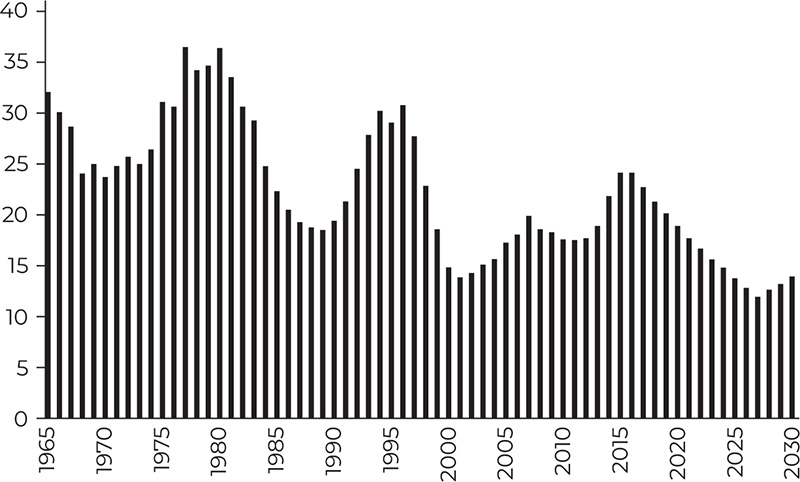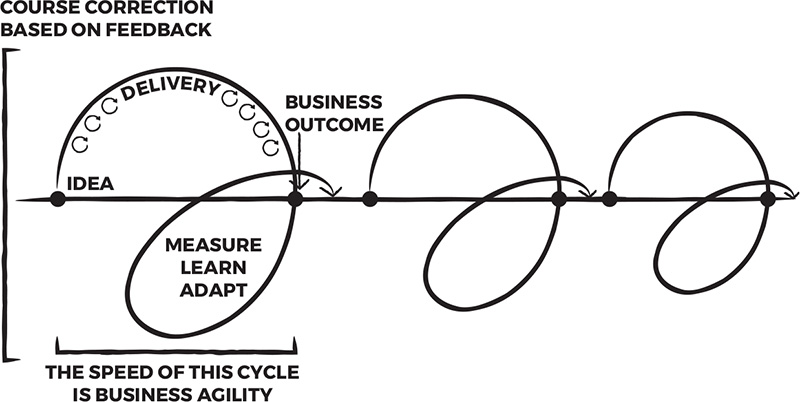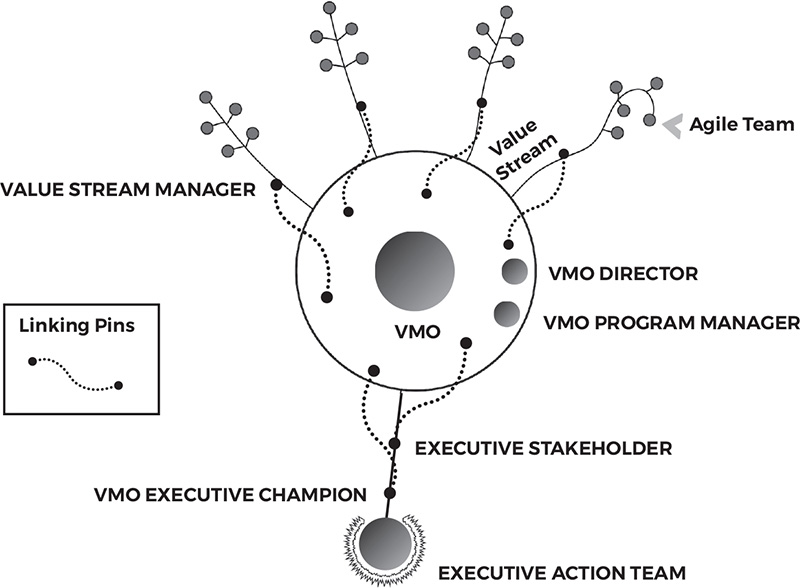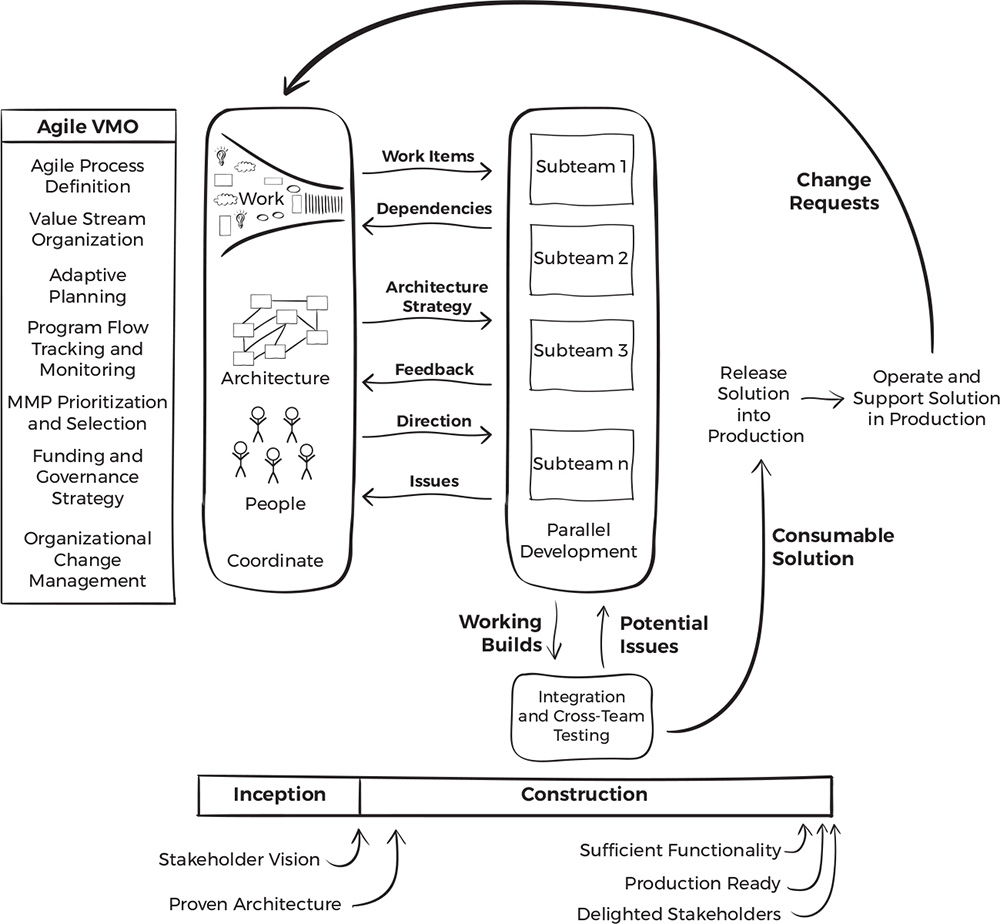
Download PDF Excerpt
Rights Information
From PMO to VMO
Managing for Value Delivery
Sanjiv Augustine (Author) | Roland Cuellar (Author) | Audrey Scheere (Author) | Sean Pratt (Narrated by)
Publication date: 09/07/2021
-Evan Leybourn, co-founder and CEO, Business Agility Institute
“By the end of this book, you will understand what is valuable, how to measure value, and how to optimize the flow of value-from idea to your customer.”
-Evan Leybourn, co-founder and CEO, Business Agility Institute
Agile methods have brought about dramatic changes in how organizations manage and deliver not only IT services, but their entire product and service value streams. As legacy organizations transition to newer, end-to-end agile operating models, the Project Management Office (PMO) needs to redesign its mission and operation to be more in line with these modern ways of working.
That requires being more customer-focused and value-adding, and less hidebound, bureaucratic and tied to antiquated processes and mindsets. Visionary leaders are transitioning into enablers of this change, and maximizing value through the entire organization. Middle management, including program and project managers (PMs), are racing to maximize their professional relevancy in this new world.
This book defines the role of the agile value management office (VMO), using case studies and a clear road map to help PMs visualize and implement a new path where middle management and the VMO are valued leaders in the age of business agility.
Find out more about our Bulk Buyer Program
- 10-49: 20% discount
- 50-99: 35% discount
- 100-999: 38% discount
- 1000-1999: 40% discount
- 2000+ Contact Leslie Davis ( [email protected] )
-Evan Leybourn, co-founder and CEO, Business Agility Institute
“By the end of this book, you will understand what is valuable, how to measure value, and how to optimize the flow of value-from idea to your customer.”
-Evan Leybourn, co-founder and CEO, Business Agility Institute
Agile methods have brought about dramatic changes in how organizations manage and deliver not only IT services, but their entire product and service value streams. As legacy organizations transition to newer, end-to-end agile operating models, the Project Management Office (PMO) needs to redesign its mission and operation to be more in line with these modern ways of working.
That requires being more customer-focused and value-adding, and less hidebound, bureaucratic and tied to antiquated processes and mindsets. Visionary leaders are transitioning into enablers of this change, and maximizing value through the entire organization. Middle management, including program and project managers (PMs), are racing to maximize their professional relevancy in this new world.
This book defines the role of the agile value management office (VMO), using case studies and a clear road map to help PMs visualize and implement a new path where middle management and the VMO are valued leaders in the age of business agility.
1.	Introducing the Agile VMO
2.	Defining an Agile VMO
3.	Organizing around Value Streams
4.	Adaptive Planning
5.	Tracking and Monitoring Program Flow
6.	Prioritizing and Selecting MMPs
7.	Evolving a Funding and Governance Strategy
8.	Managing Organizational Change
9.	Setting Up Your Agile VMO
1  Introducing the Agile VMO
Introducing the Agile VMO
On March 11, 2020, the World Health Organization declared the rapidly spreading coronavirus outbreak a pandemic. If you, like us, were among the millions around the world watching news reports with growing dread, the WHO’s announcement was merely a confirmation that the world we knew was about to be rocked by the biggest “black swan” event in over a century.
Years and perhaps even decades from now, the struggle to minimize the personal, public health, and financial impacts of the pandemic will continue. Each of us will recollect some particular memories of this unprecedented time. In the United States, there will be troubling memories of the federal government’s inadequate response and its resulting tragic human and economic impacts. By contrast, the shining examples of state governors in the United States, as well as the governments of Mongolia, Vietnam, Ghana, Trinidad and Tobago, South Korea, and New Zealand, are inspiring case studies in leadership and agility.
Like many governments, most organizations also have historically dealt with layers of red tape, internal politics, and regulations that weigh them down, slowing both innovation and the ability to confront crisis. What we are facing today is the clearest need we have ever seen for organizations in all industries to adapt and pivot quickly. Even as we debate the public examples of pandemic response, examples of business agility are lesser known because they do not make the news headlines.
Out of necessity, businesses small and large along with government agencies have responded with alacrity. Sit-down restaurants have become mini grocery stores, mom-and-pop shops have curbside pickup, and movie theaters are reembracing drive-in shows. Stretching to support these businesses are financial institutions, which processed more loans in the first weeks of April 2020 than they did during all of 2019. In a mind-bending display of mission agility, the U.S. Small Business Administration partnered with these institutions to process 29 years’ worth of loans in April and May 2020.1 Across the board, enterprises are faced with the slap-in-the-face realization that their business will never be back to the old prepandemic normal. With their revenues dropping by up to 90 percent, the airline and tourism industries will be reeling for decades. We are beginning to settle into the next normal of continued business downturn and public health uncertainty.
Even before this crisis, the average company was facing a challenge unlike any before. As shown in figure 1.1, Innosight predicted that 75 percent of the companies listed on the S&P 500 Index would be replaced by 2027, with the average company tenure trending toward 12 years, down from 60 years in the 1950s.2
For decades, technology has broken down barriers between industries and markets, increasing competition and redefining what is possible on a continuous basis. At the same time, lead times to satisfy customers have become much shorter, with constant demands for more value delivered more quickly. This turbulent business environment can be explained by the concept of VUCA (volatility, uncertainty, complexity, and ambiguity), originally coined by the U.S. Army War College to articulate Cold War conditions. In a few short weeks, the coronavirus pandemic forced all of us violently into a hyper-VUCA world.

Figure 1.1: Average company life span on the S&P 500 Index (adapted with permission from Innosight)
The only way for organizations to survive in this next normal is to deliver results more quickly, reducing the time from need to solution to its absolute minimum. Then they need to quickly adapt as necessary to converge on fit-to-purpose solutions to ever-changing customer needs. Digital technologies are rapidly redefining product development and collaboration in this turbulent landscape, and automation and globalization issues are driving business disruption. Overnight, Zoom became our virtual platform of choice and our lifeline for connecting with one another. Now that working from home has become the norm, businesses grapple with employee burnout and productivity concerns as the delineation between work and home life has all but disappeared. To survive in the short term and prosper into the future, businesses are rapidly adapting their strategies, culture, processes, and platforms.
These turbulent business conditions require clear strategy, rapid delivery, an adaptive mindset, and continuous improvement, all steered by strong leadership. Even as vaccines arrive and we begin to overcome the pandemic devastation, we know that turbulence will persist post COVID. Over the past two decades, many chief information officers and other C-suite executives had already built a foundation for business agility by launching initiatives to shorten up-front planning cycles, reduce project size, and increase speed to market by adopting agile methods (see sidebar) in some fashion.
Basics of Agile Methods
Team-Based Agile Methods
Formalized in 2001 via the Agile Manifesto, team-based Agile methods, including Scrum, extreme programming, Crystal, and feature-driven development, provide techniques for delivering customer value while creating agility through rapid iterative and incremental delivery, flexibility, and a focus on customer outcomes. Developed some years later, the Kanban method stressed flow and work-in-progress management to improve speed and throughput. Some of the basic techniques employed by team-based agile methodologies are listed here.
Small releases. Work is divided into small chunks to manage complexity and to get early feedback from customers and end users. Releases are usually delivered in one to three months.
Iterative and incremental development. Plans, requirements, design, product increments, and tests are evolved incrementally through multiple passes, or iterations, rather than through a single waterfall pass with lockdowns of each. Iterations (also called Sprints) are fixed length, usually around two weeks each to maximize feedback, and are fixed scope to retain stability.
Physical or virtual collocation. All team members are collocated physically or using a virtual collaboration tool to facilitate face-to-face communication and rich interactions. Dedicated team rooms are provided for impromptu meetings, design sessions, and other formal and informal group activities.
Product backlog. Desired features are defined at a high level and prioritized by a product owner in a product backlog. The prioritization is done collaboratively with teams. Team members provide level-of-effort estimates, and product owners decide business priority on an ongoing basis in backlog-refinement working sessions. Product owners use the product backlog to create release road maps and release plans.
Sprint/iteration backlog. High-level features from the release plan are elaborated upon and prioritized along with their implementation tasks in a Sprint or iteration backlog. The prioritization is done collaboratively with team members in a Sprint/iteration planning session. Team members provide level-of-effort estimates, and customers decide business priority.
Self-disciplined teams. Team members self-organize by continuously completing tasks collaboratively from the backlogs without top-down management control.
Flow and work-in-progress management. Agile teams visualize their flow of work, limit work in progress, and continuously identify and resolve constraints to improve speed and throughput.
Simple, lean, and adaptable. All aspects of work, including processes, are kept simple, lean (low on wastes), and adaptable to maximize customer value and to accommodate change.
Scaled Agile Methods
Scaled agile methods—including the Scaled Agile Framework (SAFe), Disciplined Agile, Scrum at Scale, Large-Scale Scrum (LeSS), and Nexus—extend Scrum, extreme programming, and to a large extent Kanban. They facilitate organizing and coordinating multiple teams into larger cohesive programs for alignment, and they link their work to strategic themes and financial portfolios for oversight, governance, and the delivery of end-to-end business outcomes.
Increasingly, DevOps practices are embedded into both team-based and scaled methods. DevOps is a blend of mindset, culture, practices, and tools that drives the rapid delivery of applications and services. A DevOps platform creates the capability for organizations to deliver, measure and improve customer outcomes.
Now, in our current pandemic era, these leaders are guiding their companies out of the crisis and into the future by building on that agile foundation. They are continuing to grow and evolve their organizations by building on the trust, transparency, and collaboration that agile methods enable. With intentional end-to-end communication, agile methods enable them to understand true customer needs in order to learn and move faster to produce innovative and in-demand products and services. Leaders have also integrated agile methods and expanded them with lean thinking, DevOps, and the cloud to deliver business outcomes. This is the essence of business agility: measuring, learning, and adapting rapidly to deliver desired business outcomes, as illustrated in figure 1.2.
Middle Management Is the Keeper of the Execution Model
By 2020, organizations of all sizes had made visible shifts toward agility. Most organizations that have adopted agile have implemented Scrum, extreme programming, Kanban, and other team-based agile methods. Many have also scaled agile methods up to the program and portfolio levels with the Scaled Agile Framework, Disciplined Agile, Large-Scale Scrum, Nexus, or Scrum at Scale.

Figure 1.2: Business agility—measuring, learning, and improving
Scaling these methods from information technology teams to programs and portfolios has not been enough. Even before the pandemic crisis, pioneering companies like Haier Group in China and the Vinci Group in France were forging ahead with postbureaucratic management. They had blown up their bureaucracy and top-down hierarchies, instead employing small, self-managing teams connected via entrepreneurial networks. See chapter 7 for more on Haier’s approach. Can we emulate these pioneers in business agility? Perhaps, but the road to success is arduous; it requires clarity of vision, constancy of purpose, and courage and persistence in the execution of a new operating model.
Work management, organizational systems, and policies in most companies are not appropriately structured to allow value to flow across the organization. Instead, in these legacy organizations, every single process, organizational structure, and role is designed to support the current and likely traditional method of delivery. Locked into the past, these rigid, hidebound structures stifle the innovation and agility crucial for an organization to succeed. This is Conway’s law3 writ large—organizations design systems that mirror their own communication structure—and something we must urgently overcome in our current crisis environment.
Sadly, in our decades of experience supporting agile change management, we have seen that individuals in middle management roles tend to offer the stiffest resistance to this critically needed change. These middle managers and junior executives are the gateway between employees in the trenches and top executives in the C-suite who determine strategy. This frozen middle, as it is referred to in management circles, is entrusted with owning the execution model of any strategy or process. They are the ones most invested in the status quo, having worked hard to gain their current position, with years and sometime decades invested in the legacy organizational models. Critically, as organizations transition to a newer end-to-end agile operating model, the roles of middle management need to change to unfreeze the frozen middle. Specifically, these roles will need to be adapted to support agile teams and lead the rapid delivery of value. With such a change, middle management can be freed to champion and lead change, rather than being restricted in organizational structures and roles that impede it. These changes are quite dramatic and must be brought about by executive leaders who understand that they are critical to the survival of their organizations and who have the courage of conviction and the temerity to implement radical change at all levels.
As a cocustodian of the legacy models, project management offices (PMOs) desperately need reinvention as well. Originating in the 1800s as project offices and gaining widespread acceptance and application in the 1900s, contemporary PMOs unfortunately still retain vestiges of legacy industrial-age models, with adherence to bygone practices like implementing rigid, top-down management by objectives or enforcing the iron triangle (cost, time, scope) on projects even as they fail to deliver customer value. As the world has moved on to newer evolutions like quarterly objectives and key results and transitioned from a project to a product model, PMOs remain mired in the past. They have thus become too closely associated with past failures and are not typically identified with newer agile methods or even with postbureaucratic management in general.
PMOs Are under Attack
As organizations become more adaptable and responsive, they are starting to adopt more of a product mindset, which calls into question the need for projects at all. Projects are, after all, an internal construct. Our customers do not care about our projects, our budgets, or even our controls. What they care most about are solutions to their problems through the timely delivery of value, as represented by product features and fixes or service innovations. Because of this fundamental difference in focus, and because PMOs are not associated with newer models of business agility, they are coming under increasing scrutiny and are being pressured to justify their existence in the new age of agile.
Consider the following:
• Project management as a role and as a function is being attacked for being slow, bureaucratic, costly, and at times ineffective. Project management is also unfortunately quite closely linked to waterfall execution models.
• Agile ways of working are quickly leaving the old waterfall execution paradigm behind, making the tools and techniques of most project managers and PMOs more and more irrelevant.
• New roles such as product owners, scrum masters, and release train engineers are starting to chip away at some of the traditional duties of the project manager.
• DevOps and automation tools are starting to provide extreme levels of visibility into progress and quality, lessening the need for traditional forms of reporting.
• The relentless pursuit of cost cutting, profit, and growth makes any function that does not directly add value a potential target for downsizing.
The result of these and other forces is that the traditional PMO and the project managers within it are increasingly under attack, even in the public sector or large and highly regulated private-sector firms. The classical PMO, too closely wedded to management models popular in the 1950s and to waterfall execution in the current age, needs to embrace transformation to stay relevant or to even exist in an agile organization.
Paradoxically, even as middle management is popularly identified with bureaucracy and rigidity, middle managers have been identified as pivotal leaders of successful change management efforts.4 In the 2020s pandemic era, many organizations worldwide will be struggling to emerge from the crisis in a turbulent sea of rapid and continuous change, even as other, nimbler organizations navigate the crisis successfully. Middle management in general and the PMO in particular have a rare opportunity to lead change from the front and drive value, instead of fading further into obscurity and obsolescence.
Transforming the PMO into an Agile VMO
How can the PMO lead in the modern pandemic age? How can the PMO repurpose itself and redesign its mission and operation to be more value adding, less bureaucratic, more customer focused, and more in line with agile product management and other modern ways of working? We believe that, to accomplish this, the PMO needs to rapidly evolve into the Agile Value Management Office, or Agile VMO®. This transition will represent a huge change for most organizations, and they must provide a formal structure to guide the PMO’s evolution into the Agile VMO.
As illustrated in figure 1.3, the VMO’s formal structure consists of a small, cross-functional, cross-hierarchy team with key representatives who work collaboratively across the organization.
The VMO has members who function as linking pins across organizational silos and between hierarchical levels. These members will have roles in both the VMO and their organizational units and will ensure tight linkages between the VMO and those organizational units. The key roles in the VMO are director, program manager, and executive champion. The VMO includes executive action team stakeholders, value stream managers, and agile team representatives from across value streams and teams. In chapter 9 we provide a detailed explanation of how to implement this structure in your organization.

Figure 1.3: The Agile VMO—an end-to-end, cross-hierarchy team driving business agility
Achieving true end-to-end business agility requires transitioning to this new Agile VMO structure, as well as the methodical restructuring of processes and structures along the entire value stream, from business strategy to operations and every step along the way.
The VMO has a strategic responsibility to drive organizational change and the day-to-day responsibility to help manage a dynamic, active portfolio of work in partnership with value stream managers. All the VMO’s work functions and its members’ corresponding responsibilities are listed in table 1.1.
We will cover these in detail in the rest of the book and summarize them in chapter 9. As an applied example, figure 1.4 illustrates how this plays out with Disciplined Agile’s program life cycle for a team of teams. As a team of teams, the VMO can help agile teams using Disciplined Agile define their way-of-working processes, help them optimize flow, provide program oversight and governance, and support program coordination.5
Table 1.1. VMO Responsibilities
Agile VMO Function |
Responsibilities |
Defining an agile process |
• Establish high discipline as the driving goal for all your agile processes • Take a calibrated approach to defining your agile processes • Define metrics that support and drive dynamic transformation • Develop process controls as natural outputs of the process |
Organizing around value streams |
• Organize as adaptive networks of teams • Define flexible value streams by customer journeys • Establish the VMO as a team of teams • Fund experience-aligned teams by value stream |
Adaptive planning |
• Conform to value, rather than comply to plan • Plan, deliver, and measure in small batches • Measure business outcomes, not stage outputs • Sense and respond to business conditions • Apply adaptive planning at multiple levels • Conduct strategy planning • Conduct portfolio planning • Conduct product and release planning • Conduct Sprint/iteration and daily planning |
|
• Understand visual management systems • Track and monitor program flow with visual management systems • Measure and improve flow • Drive continuous learning and adaptation |
|
Prioritizing and selecting minimally marketable products (MMPs) |
• Plan for a fundamental shift from project to MMP delivery • Select MMPs for maximum financial impact • Use weighted shortest job first to prioritize and select the most impactful options • Deliver the MMP and learn |
Evolving a funding and governance strategy |
• Keep your funding model flexible • Provide fixed funding for value streams • Strategize more frequently; annual is not enough • Monetize at the feature level • Devise a fixed-cost model for your stable agile teams • Adopt business outcomes as key governance controls • Utilize a lean business case • Require frequent delivery, and measure incremental business results • Recognize that it is fundamentally about the time value of money |
Managing organizational change |
• Recognize that change is extraordinarily difficult • Design and set up a holistic change management system • Position the VMO to drive the change |

Figure 1.4: The Agile VMO and Disciplined Agile’s team of teams (adapted with permission from PMI)
In following chapters, learn how to set up an Agile VMO and explore all the fundamental aspects of the VMO’s work:
• In chapter 2, understand how to define an agile process at your organization.
• In chapter 3, explore how to reconfigure and organize around value streams.
• In chapter 4, implement adaptive planning at all organizational levels, from the top of your organization down to your agile teams.
• In chapter 5, explore how to use visual management systems and other key techniques to track and monitor program flow.
• In chapter 6, learn to decompose projects and products into smaller increments by prioritizing and selecting MMPs.
• In chapter 7, extend these concepts to business considerations by evolving a funding and governance strategy.
• In chapter 8, consider ways to manage organizational change.
• Finally, in chapter 9, make a detailed plan to set up your own Agile VMO.
To get a flavor of how the VMO has been implemented in industry to achieve business outcomes, see the sidebar for a case study from Nationwide Insurance.6
CASE STUDY: IMPLEMENTING THE AGILE VMO AT NATIONWIDE INSURANCE
How has the Agile VMO been implemented in leading organizations? Nationwide Insurance is a Fortune 100 company that has won many accolades over the years. The company has been implementing lean and agile methods since 2007 and had over 230 agile teams, mostly within the information technology department, as of early 2019.
At a 2019 agile industry conference, Nationwide’s associate vice president Charles Kennedy presented the following case study. The Enterprise Digital group at Nationwide implemented a VMO with exceptional results: going from a single monthly release to 50 times a month, improving business-side velocity by 67 percent, improving end-to-end cycle time by 30 percent, and reducing costs simultaneously by 15 percent.
Despite advanced agile capability within software development, Nationwide Insurance had an existing “Scrummerfall” approach, as shown in figure 1.5. This antipattern is prevalent across the industry, since most agile adoptions originate within IT and have been driven by CIOs.
At Nationwide, long, linear, upfront planning cycles eventually fed work to agile delivery teams, only to then have the completed work languish in further waterfall steps toward deployment. Nationwide’s highly visible and competitive digital channels, such as customer-facing websites, mobile apps, and voice channels, required a far more responsive model.

Figure 1.5: Typical agile-only-in-IT antipattern
In late 2016, the Nationwide Enterprise Digital group began a business transformation to further improve speed to market and increase flexibility in the highly competitive digital customer-facing channel environment. Nationwide’s VMO transformation had three key elements:
• Realigning the organization around value streams as represented by customer journeys, and populating them with end-to-end teams for flow, throughput, and customer outcomes
• Driving collaboration across organizational silos using big room planning to minimize the effect of silos and dependencies
• Prioritizing MMPs to deliver customer value with maximum speed and minimum waste
According to Kennedy, enterprise digital teams partnered across business and IT to successfully pilot an end-to-end model with the Agile VMO that worked directly with end business units and customers. This model then spread organically to other groups within the company.
Summary
The dust is settling on the next normal in our pandemic era. Agile methods have provided a rock-solid foundation on which to grow and evolve an organization. Organizations can drive business agility in the pandemic era and beyond by understanding true customer needs, learning, and moving faster to produce innovative and in-demand products and services.

Figure 1.6: Collaboration across silos with big room planning
As legacy organizations transition to a newer end-to-end agile operating model, the roles of middle management need to unfreeze and not only accept but encourage change. The PMO needs to redesign its mission and operation to be more value adding, less bureaucratic, more customer focused, and more in line with agile product management and other modern ways of working. The PMO must be repurposed toward value management. To accomplish this, the PMO needs to rapidly evolve into an Agile VMO.
Achieving true end-to-end business agility requires transitioning to a new VMO team-of-teams structure and methodical restructuring of processes and structures along our organization’s entire value stream.
To begin exploring the VMO team-of-teams model, try out the popular organizational planning technique known as big room planning. This technique is an agile practice that helps multiple teams align and coordinate on business goals and product releases. The essential concept is for everyone involved to congregate in a big room and plan together, as illustrated in figure 1.6. While typically done quarterly, big room planning can also be held on a tighter cadence (e.g., monthly) in fast-moving environments. See chapter 4 for how to prepare for and run an in-person or virtual two-day big room planning event.













